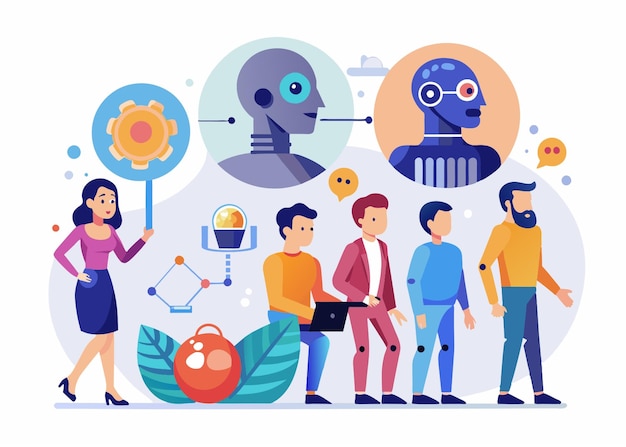Navigating Ethical Dilemmas in AI: A Pragmatic Approach for Business Leaders
In today’s rapidly evolving digital landscape, Artificial Intelligence (AI) has become a game-changer for businesses seeking to gain a competitive edge. However, as AI systems grow more sophisticated and pervasive, they also raise complex ethical dilemmas that require the attention of business leaders. In this article, we will explore a practical approach to navigating ethical dilemmas in AI.
Understanding Ethical Dilemmas in AI
First, let’s define what we mean by ethical dilemmas in the context of AI. Ethical dilemmas refer to situations where AI systems make decisions that challenge our moral and ethical values. For instance, an autonomous vehicle might be programmed to save the lives of its passengers in a collision, but what if doing so would result in the deaths of innocent bystanders? These types of dilemmas can be challenging to navigate and require careful consideration.
Identifying Ethical Dilemmas in AI
To identify ethical dilemmas, it’s essential to understand how AI systems function and the potential consequences of their decisions. Transparency is key here, as business leaders must be able to explain the reasoning behind AI systems’ decisions and ensure they align with ethical principles. Additionally, regular audits of AI systems can help identify potential ethical dilemmas before they become significant issues.
Assessing the Impact of Ethical Dilemmas
Once ethical dilemmas have been identified, it’s crucial to assess their potential impact. For example, a social media platform might use ai to filter out content that violates community standards. However, if this filtering algorithm inadvertently removes content that should be protected under freedom of speech, it could have significant consequences for users and the platform’s reputation.
Addressing Ethical Dilemmas in AI
To address ethical dilemmas, businesses must take a proactive approach. This might involve revising ai systems’ programming or implementing new policies and guidelines. Additionally, engaging with stakeholders, including employees, customers, and regulatory bodies, can help build trust and foster a culture of ethical ai usage.
The Role of Regulation in Ethical Dilemmas
Regulation plays a crucial role in addressing ethical dilemmas in AI. Governments and regulatory bodies are increasingly focusing on developing guidelines and frameworks to ensure that AI is used ethically and responsibly. For example, the European Union’s General Data Protection Regulation (GDPR) provides guidelines for collecting, processing, and storing personal data in an ethical manner.
Conclusion
Navigating ethical dilemmas in AI requires a pragmatic and proactive approach. By understanding the nature of ethical dilemmas, identifying potential issues, assessing their impact, and addressing them through transparent policies and guidelines, businesses can ensure that AI is used ethically and responsibly. Additionally, engaging with stakeholders and regulators can help build trust and foster a culture of ethical AI usage in today’s digital landscape.

Exploring the World of Assistive Technologies: A Comprehensive Overview
Assistive technologies are digital tools and services designed to help individuals with disabilities or special needs to perform tasks that might otherwise be difficult or impossible. These technologies have revolutionized the way people live, learn, work, and play, providing new opportunities for inclusion and independence. In this comprehensive overview, we will boldly explore various types of assistive technologies, their key features, and the ways they support individuals with different disabilities.
Text-to-Speech Technologies
One of the earliest and most popular types of assistive technologies is text-to-speech (TTS). TTS systems convert written text into spoken words, making information accessible to individuals with visual impairments, dyslexia, or other reading difficulties. Modern TTS engines are advanced enough to produce natural-sounding speech, enabling users to read books, documents, and web content out loud.
Speech Recognition Technologies
Another essential category of assistive technologies is speech recognition, which allows users to interact with computers and digital devices using their voice instead of typing or using a keyboard. This technology is particularly valuable for individuals with mobility impairments, dyslexia, or those who find typing challenging. Speech recognition has become increasingly sophisticated over the years, with some systems even able to recognize idiomatic expressions and context-specific language.
Captioning and Transcription Technologies
Captioning and transcription technologies enable individuals who are deaf or hard of hearing, as well as those with learning disabilities or English language learners, to access multimedia content and spoken communication. Closed captioning is a textual version of the speech or other sounds in audiovisual media, which appears on screen. Transcription refers to converting spoken language into written format. These technologies provide equal access to vital information and promote inclusion in various settings.
Mobility and Navigation Assistive Technologies
For individuals with mobility impairments, assistive technologies can help navigate the physical environment and make everyday tasks easier. Examples include voice recognition software, adaptive keyboards and mice, and assistive mats and switches for those who cannot use traditional input devices. Additionally, mobility aids like wheelchairs can be equipped with advanced features such as obstacle detection and self-navigation, enabling users to move around more independently.
Communication Assistive Technologies
Communication assistive technologies cater to individuals who have difficulty speaking or expressing themselves through written language. Augmentative and alternative communication (AAC) systems include text-to-speech devices, speech synthesizers, and picture communication symbols. These technologies help individuals communicate more effectively, participate in social situations, and express their thoughts and feelings.
Assistive Technologies for Learning and Education
Assistive technologies can also be invaluable tools for individuals with learning disabilities or those who need additional support to succeed academically. Examples include text-to-speech software, screen readers, and speech recognition systems. These technologies enable students with various learning needs to access curriculum materials more effectively, take notes, and complete assignments with greater ease.
Assistive Technologies for Employment
In the workplace, assistive technologies can help individuals with disabilities perform tasks more efficiently and effectively. Examples include screen magnifiers, voice recognition software, and adaptive keyboards. These technologies not only improve productivity but also promote inclusion in the workforce by providing equal opportunities for individuals with disabilities to excel and contribute their skills and talents.

Artificial Intelligence (AI) is increasingly becoming an integral part of business operations across industries. From customer service and marketing to finance and human resources, AI’s ability to process large amounts of data quickly and accurately is revolutionizing the way businesses operate. However, this technological advancement also presents ethical dilemmas that business leaders must address.
Privacy and Security Concerns
One of the most pressing ethical concerns is data privacy. With AI systems collecting and analyzing vast amounts of personal data, there is a risk of breaches that could lead to identity theft and other forms of fraud. Businesses must ensure they have robust security measures in place to protect their customers’ data, as well as transparent privacy policies that explain how the data will be used.
Bias and Discrimination
Bias and discrimination
in AI systems
is another ethical concern. Biased data can lead to biased outcomes, perpetuating unfair treatment and discrimination. Businesses must ensure that their AI systems are trained on diverse and representative datasets to mitigate this risk.
Accountability and Transparency
The lack of transparency
in some AI systems
can also be a problem. When decisions are being made by algorithms that are not easily understood, it can lead to a lack of trust in the system and potentially even legal issues. Businesses must ensure that they can explain how their AI systems are making decisions and be transparent about their use.
Impact on Employment
Finally, there is the ethical question of what impact AI will have on employment. While AI has the potential to create new jobs, it also has the potential to displace existing ones. Businesses must consider how they can support their employees through this transition and ensure that they are not unfairly targeting certain roles or individuals.
Addressing Ethical Dilemmas
It is essential that businesses address these ethical dilemmas to maintain public trust, reputation, and legal compliance. By being transparent about their use of AI, ensuring that their systems are fair and unbiased, and taking steps to mitigate privacy concerns, businesses can build trust with their customers and employees. Failure to do so could result in significant reputational damage, legal action, or even regulatory intervention.
Understanding Ethical Dilemmas in AI Context
Artificial Intelligence (AI) is a rapidly evolving technology that has the potential to revolutionize various industries and aspects of our daily lives. However, as with any powerful technology, there are ethical dilemmas that arise in its implementation. These dilemmas can be complex and multifaceted, often involving issues of
transparency
,
accountability
,
privacy
, and
bias
.
Transparency: One ethical dilemma is the need for transparency in how AI systems make decisions. While AI can process vast amounts of data and identify patterns that humans may miss, the reasoning behind these decisions is not always clear to humans. This lack of transparency can lead to mistrust and misunderstanding, especially in areas where AI impacts human lives significantly, such as healthcare or criminal justice.
Accountability: Another ethical dilemma is the question of accountability. Who is responsible when an AI system makes a mistake or causes harm? The developer, the user, or the AI itself? This question becomes even more complex when considering that AI systems can learn and adapt over time, making it difficult to assign blame.
Privacy: Privacy is another significant ethical issue in the context of AI. With the vast amounts of data that AI systems can process, there are concerns about how this data is collected, stored, and used. There is a risk of breaches and misuse of sensitive information, leading to potential harm to individuals or groups.
Bias: Lastly, there is the issue of bias in AI systems. Biases can be intentional or unintentional and can result from the data used to train the system, the algorithms used, or even the developers’ perspectives. Biases in AI systems can lead to unfair treatment and discrimination against certain groups.
Addressing these ethical dilemmas requires a multifaceted approach that involves not only technical solutions but also legal frameworks and public awareness. It is essential to have ongoing conversations about these issues to ensure that AI is developed and implemented in a way that benefits society as a whole.

Exploring Ethical Dilemmas in Artificial Intelligence: A Clash of Values and Interests
Ethical dilemmas, as the name suggests, refer to complex situations that compel individuals or organizations to make decisions between conflicting values or interests. These dilemmas can arise in various domains and contexts, often leading to moral quandaries that challenge our beliefs, principles, and judgment. In the rapidly evolving world of Artificial Intelligence (AI), ethical dilemmas assume a unique and intriguing dimension, manifesting in diverse forms such as privacy concerns, bias, accountability, and more.
Privacy Concerns: Balancing Individual Rights vs. Data Collection
One of the most prominent ethical dilemmas in AI revolves around privacy. With the proliferation of digital technologies, vast amounts of personal data are being generated, collected, and analyzed every day. AI systems often rely on this data to learn and improve, leading to a tension between the individual’s right to privacy and the organization’s interest in maximizing data usage. For instance, a retailer might use AI to personalize marketing campaigns based on a customer’s browsing history or purchase behavior, but this practice could be perceived as an invasion of privacy by the individual.
Bias: Unintended Consequences and Discrimination
Another ethical concern in AI is the issue of bias. AI systems learn from data, and if that data reflects societal biases or prejudices, the resulting algorithms may perpetuate or even exacerbate these issues. For example, a facial recognition system that is trained on a dataset predominantly composed of white individuals might struggle to accurately identify people with darker skin tones. This can lead to discrimination, unfair treatment, and negative consequences for marginalized communities.
Accountability: Establishing Responsibility in a Complex System
Lastly, the question of accountability arises when things go wrong in AI systems. Who is responsible for the actions or outcomes of an AI system? Is it the developers who designed and built the system, the users who interacted with it, or the AI itself? This ethical dilemma is further complicated by the complexity of AI systems and their ability to learn and adapt autonomously. For instance, if an autonomous vehicle causes an accident due to a programming error or a misinterpretation of its environment, who is liable for damages?
Conclusion: Navigating Ethical Dilemmas in AI
In conclusion, ethical dilemmas are a pervasive and essential aspect of artificial intelligence, surfacing in various forms such as privacy concerns, bias, accountability, and beyond. As we continue to develop and deploy AI systems, it is crucial that we acknowledge these dilemmas and work towards creating solutions that respect individual values, promote fairness, and establish a clear chain of responsibility. By engaging in open dialogues and collaborative efforts, we can shape the future of AI to be not just technically advanced but also ethically sound.

I Pragmatic Approach for Business Leaders:
In today’s interconnected world, business leaders face numerous ethical dilemmas that can significantly impact their organizations’ reputations and bottom lines. A pragmatic approach to addressing these challenges involves adopting a well-defined ethical framework that aligns with the organization’s mission, values, and culture.
Defining Ethical Frameworks:
An ethical framework is a set of guiding principles that help organizations navigate complex ethical situations. It provides a clear and consistent approach to decision-making, ensuring that business practices are not only legal but also morally sound. A well-designed ethical framework addresses the following areas:
Transparency:
Transparency involves open communication and accountability to stakeholders about the organization’s business practices, financial reporting, and governance.
Integrity:
Integrity encompasses honesty, fairness, and trustworthiness in all dealings with customers, employees, suppliers, and competitors.
Respect for Stakeholders:
Respecting stakeholders means recognizing the rights, values, and interests of all those affected by the organization’s actions. This includes employees, customers, shareholders, suppliers, and the wider community.
Responsibility:
Responsibility implies that organizations must consider not only their short-term financial interests but also the long-term impact of their actions on stakeholders and society as a whole.
Implementing Ethical Frameworks:
To implement an ethical framework effectively, business leaders should:
Establish a clear and visible ethical vision:
Create a compelling and inspiring statement of the organization’s commitment to ethics, which is communicated throughout the organization.
Develop and disseminate ethical policies:
Develop a comprehensive set of ethical guidelines that address the organization’s key areas of risk. Ensure these policies are easily accessible to all employees and regularly reviewed and updated.
Implement effective training programs:
Provide regular ethics training to all employees, ensuring they understand the importance of ethical behavior and are equipped with the necessary tools to navigate complex situations.
Establish an effective reporting mechanism:
Create a secure and confidential reporting channel that enables employees to report ethical concerns without fear of retaliation. This can include an anonymous hotline or dedicated email address.
5. Encourage a culture of ethical behavior:
Encourage a culture that rewards ethical behavior and discourages unethical practices. This can be achieved through performance metrics, incentives, and recognition programs.
6. Monitor and enforce compliance:
Regularly review and assess the organization’s adherence to ethical policies, addressing any deviations promptly and effectively. This can be achieved through audits, risk assessments, and performance evaluations.
Conclusion:
In conclusion, a pragmatic approach to ethical challenges for business leaders involves adopting a well-defined ethical framework that aligns with the organization’s mission, values, and culture. By focusing on transparency, integrity, respect for stakeholders, responsibility, and implementing effective training programs, reporting mechanisms, and a culture of ethical behavior, business leaders can navigate the complex ethical landscape and build trust with stakeholders.

Ethical Frameworks in AI Decision-making: Utilitarianism, Deontology, and Virtue Ethics
In the rapidly evolving world of Artificial Intelligence (AI), business leaders are faced with numerous ethical dilemmas that require thoughtful and well-informed decision-making. This paradigm shift calls for a solid understanding of various ethical frameworks that can guide and inform these critical choices. In this context, we will explore three prominent ethical theories: Utilitarianism, Deontology, and Virtue Ethics.
Utilitarianism: Maximizing Overall Happiness
Utilitarianism, a consequentialist theory, posits that an action is morally right if it maximizes overall happiness and minimizes suffering. The primary goal of this ethical framework is to create the greatest good for the greatest number of individuals. In the context of AI decision-making, business leaders might consider how their actions will impact the happiness and well-being of a broad range of stakeholders, including customers, employees, and society as a whole.
Advantages:
- Encourages a focus on positive outcomes for all stakeholders
- Promotes social welfare and the greater good
Limitations:
- May overlook individual rights and duties
- Can be complex to determine the greatest good for all
Deontology: Moral Duties
Deontology, an ethical theory put forth by Immanuel Kant, emphasizes moral duties and rules, rather than focusing on outcomes or consequences. The central idea is that certain actions are inherently right or wrong, regardless of their effects. For business leaders implementing AI, the deontological approach might involve examining moral rules and guidelines to ensure that their use of AI aligns with these principles.
Advantages:
- Maintains a focus on moral principles and rules
- Provides clear-cut guidelines for ethical decision-making
Limitations:
- May not account for context and specific situations
- Can be inflexible in addressing complex ethical dilemmas
Virtue Ethics: Character-Based Morality
Virtue ethics, a character-based approach to morality, asserts that the best actions are those taken by individuals with good character. This ethical framework suggests that business leaders should strive to cultivate virtues such as honesty, compassion, and wisdom in their decision-making processes. By considering the moral character of AI systems and their potential impact on society, leaders can make more ethically sound decisions.
Advantages:
- Focuses on the moral character of individuals and their actions
- Encourages personal growth and development
Limitations:
- Can be subjective in determining which virtues are most important
- May not provide clear-cut guidelines for complex ethical dilemmas

Pragmatic Approach for Business Leaders: Ethical Governance
In today’s business world, ethical governance has become a crucial aspect for every organization striving for success. It is not just about complying with laws and regulations but going beyond to establish a culture that fosters transparency, accountability, and integrity. Ethical governance is essential for building trust with stakeholders, maintaining a good reputation, and ultimately, driving sustainable business growth.
Understanding Ethical Governance
Ethical governance refers to the systems, processes, and policies that an organization has in place to ensure ethical behavior and decision-making. It involves creating a framework that encourages and supports ethical conduct at all levels of the organization, from the boardroom to the frontline employees.
Why is Ethical Governance Important?
Transparency: Ethical governance ensures that an organization operates with transparency, making it easier for stakeholders to understand the company’s activities, decisions, and financial reports.
Accountability
Accountability: Ethical governance promotes accountability, ensuring that individuals and teams take responsibility for their actions and decisions. This helps to build trust and confidence with stakeholders and maintains the organization’s reputation.
Compliance
Compliance: Ethical governance helps organizations to comply with laws and regulations, reducing the risk of legal action and financial penalties.
Risk Management
Risk management: Ethical governance plays a crucial role in managing risks, especially those related to ethics and compliance. It helps organizations to identify potential ethical issues and take proactive measures to address them before they escalate into major problems.
Implementing Ethical Governance
Implementing ethical governance requires a pragmatic approach that balances the organization’s goals with its ethical responsibilities. Business leaders need to create an ethical culture where ethical behavior is not only expected but rewarded. This involves setting clear policies and guidelines, providing regular training, and establishing effective communication channels. It also means taking swift action when ethical issues arise and holding individuals accountable for their actions.
Benefits of Ethical Governance
Building Trust: Ethical governance helps organizations to build trust with stakeholders, including employees, customers, investors, and regulators.
Maintaining Reputation
Maintaining reputation: Ethical governance helps to maintain the organization’s reputation, which is essential for attracting and retaining customers and talent.
Sustainable Business Growth
Sustainable business growth: Ethical governance is essential for driving sustainable business growth, as it builds trust and confidence with stakeholders and helps organizations to navigate ethical challenges effectively.

Ethical Governance: A Crucial Process for Managing Ethical Decision-making in AI Applications
Ethical governance, as the name suggests, is a critical process that entails managing and guiding ethical decision-making in AI applications. With the increasing integration of AI systems into various aspects of our lives, the need to establish ethical guidelines and frameworks is more pressing than ever. Ethical governance serves as a means to ensure that these systems align with our moral values, principles, and ethical standards.
Roles and Responsibilities of Various Stakeholders
The responsibility for ethical governance does not rest solely on the shoulders of AI developers. Instead, it’s a collective effort shared by various stakeholders, including:
- Board Members: They set the tone for ethical governance by establishing a culture that values ethics, transparency, and accountability.
- Executives: They allocate resources, define policies, and provide leadership to ensure ethical decision-making at the organizational level.
- Employees: They are responsible for implementing ethical policies and adhering to ethical guidelines in their day-to-day work.
- Regulators: They establish and enforce ethical standards, ensure compliance with regulations, and hold organizations accountable for any ethical lapses.
- Users: They interact with AI systems and have the power to demand transparency, explainability, and accountability from AI developers and organizations.
Best Practices for Ethical Governance in AI
To establish effective ethical governance in AI, organizations should consider the following best practices:
Define Ethical Guidelines and Standards
Organizations should define clear ethical guidelines and standards that align with their values, principles, and legal requirements.
Develop Transparent AI Systems
Transparency is essential for building trust in AI systems and ensuring that their decisions are ethical. Organizations should strive to make their AI systems explainable, accountable, and open to scrutiny.
Establish Ethics Committees or Boards
Organizations should consider establishing ethics committees or boards to provide oversight, guidance, and expertise on ethical matters related to AI.
Provide Ethics Training
Providing ethics training to employees and stakeholders helps ensure that everyone understands the importance of ethical decision-making and is equipped with the necessary skills and knowledge to make informed decisions.
5. Foster a Culture of Ethical Decision-making
Organizations should foster a culture that values ethical decision-making and provides incentives for ethical behavior. This includes creating an open and inclusive environment where ethical concerns can be raised and addressed.

Pragmatic Approach for Business Leaders: Ethical Training and Education
In today’s business world, ethics and moral values are increasingly becoming essential components of an effective leadership strategy. The pragmatic approach to ethical training and education for business leaders acknowledges the importance of both theoretical knowledge and practical application. This approach seeks to provide leaders with the necessary skills and understanding to navigate ethical dilemmas in the workplace while maintaining a focus on achieving business objectives.
The Role of Ethics in Business
Ethical issues are an inevitable part of any organization, and their impact can be far-reaching. Unethical behavior can lead to legal consequences, reputational damage, loss of customer trust, and ultimately, financial losses. Conversely, ethical leadership has been shown to foster a positive work environment, promote employee engagement, and contribute to long-term organizational success.
The Importance of Training and Education
Effective ethical training and education for business leaders is crucial in preventing unethical conduct and fostering a culture that encourages ethical behavior. Such programs should cover topics such as business ethics, legal compliance, corporate social responsibility, and decision-making under conditions of uncertainty or ambiguity.
Components of an Effective Ethical Training Program
An effective ethical training program should be interactive, engaging, and customized to meet the specific needs of the organization and its leaders. It may include elements such as case studies, role-playing exercises, simulations, workshops, and group discussions. Additionally, it should provide opportunities for ongoing learning and development to ensure that leaders remain current with evolving ethical challenges in the business world.
Benefits of Ethical Training for Business Leaders
Investing in ethical training and education for business leaders offers numerous benefits, including:
– Enhancing organizational reputation and public trust
– Fostering a culture of integrity and transparency
– Improving decision-making abilities and reducing risk
– Attracting and retaining top talent
– Enhancing the ability to build and maintain strong relationships with stakeholders, including employees, customers, investors, and the community.
Conclusion
By adopting a pragmatic approach to ethical training and education for business leaders, organizations can effectively equip their leaders with the necessary skills and knowledge to navigate ethical dilemmas while maintaining a focus on achieving business objectives. This approach recognizes that ethics is not just an abstract concept but a practical necessity for long-term organizational success.

Equipping Employees with Ethical Decision-Making Skills in AI Contexts: A Necessity
In the age of artificial intelligence (AI), ethical decision-making has taken on renewed importance. As businesses increasingly rely on AI to optimize operations and enhance customer experiences, the potential for ethical dilemmas arises. It is imperative that employees are well-equipped with the necessary knowledge and
The Need for Ethical Training Programs
To address this need, organizations should consider implementing ethical training programs. These programs can provide employees with a solid understanding of ethical issues in AI and the tools they need to make informed decisions. Topics may include
data ethics
,
algorithmic fairness
, and
human-AI collaboration
. By offering regular training, organizations demonstrate their commitment to ethical business practices while empowering employees to contribute to a culture of responsibility and transparency.
Strategies for Effective Ethical Training
Effective ethical training strategies include:
- Interactive learning experiences: These can include case studies, simulations, and group discussions that encourage critical thinking and collaboration.
- Clear communication of ethical policies: Provide employees with a clear understanding of company policies and their role in upholding them.
- Providing resources: Offer access to relevant publications, workshops, and external training programs that can expand employees’ knowledge and skills.
- Encouraging open communication: Create a culture where employees feel comfortable discussing ethical concerns with their colleagues and superiors.
- Regular evaluations: Periodically assess the effectiveness of training programs and make adjustments as needed to ensure they remain relevant and engaging.
The Role of Continuous Learning in Ethical Decision-Making
Continuous learning is essential for ethical decision-making in AI contexts. As technology evolves, so too must our understanding of the ethical implications. Organizations that invest in their employees’ ongoing education not only foster a culture of innovation but also one of ethical responsibility. By keeping employees up-to-date with the latest developments and trends, organizations can ensure they are prepared to navigate any ethical challenges that arise.

VI. Case Studies: Ethical Dilemmas in AI and Practical Solutions
In the rapidly evolving world of Artificial Intelligence (AI), ethical dilemmas are increasingly becoming a major concern. From facial recognition technology raising privacy concerns to autonomous vehicles making life-or-death decisions, ethical questions about AI are not only complex but also far-reaching. Let’s explore some case studies that illustrate these dilemmas and propose practical solutions.
Facial Recognition Technology: Invasion of Privacy or Security?
Facial recognition technology, once hailed as a major breakthrough in security and convenience, has turned into a double-edged sword due to privacy concerns. Cases like the controversial use of this technology by law enforcement agencies to identify protesters or track students have sparked heated debates about privacy and civil liberties. A practical solution could be transparency, where organizations are clear about their data collection policies and provide opt-out options for individuals.
Autonomous Vehicles: Life or Death Decisions
Autonomous vehicles promise to revolutionize transportation, but they also pose ethical dilemmas. For instance, what should an autonomous vehicle do if it’s about to hit a pedestrian or swerve and hit another car instead? This is known as the trolley problem. Various ethical frameworks like utilitarianism, deontology, and virtue ethics have been proposed to solve this dilemma. A practical solution could be programming the vehicle to prioritize human lives over property damage while considering contextual factors like road conditions and passenger safety.
AI in Hiring: Discrimination or Efficiency?
AI is increasingly being used in hiring, but it can also perpetuate discrimination. For instance, if an AI system is biased against a particular gender or race based on historical data, it could unfairly exclude qualified candidates. A practical solution could be regularly auditing the AI system’s data and algorithms for bias, providing opportunities for humans to override AI decisions, and creating diverse development teams.
Conclusion:
These case studies highlight the ethical dilemmas in AI and provide practical solutions. By addressing these issues, we can ensure that AI is developed and used responsibly, ethically, and inclusively.

Real-world Ethical Dilemmas Faced by Businesses in Implementing AI:
Artificial Intelligence (AI) is revolutionizing businesses, bringing about unprecedented opportunities and challenges. One of the most pressing issues is ethical dilemmas that arise when implementing AI systems. Let’s explore some real-world examples and discuss potential solutions using ethical frameworks and governance approaches.
Example 1: Amazon’s Hiring Algorithm
In 2018, Amazon‘s recruitment team developed an AI-powered hiring tool to review resumes and identify top candidates. However, the system was biased against women as it learned from past hiring patterns that predominantly favored male applicants.
Description of the Situation:
Amazon’s AI hiring system, designed to increase efficiency and objectivity in the recruitment process, instead perpetuated gender bias due to the data it was trained on.
Conflicting Values:
Fairness, Equality, and Non-discrimination
Potential Consequences:
Excluding qualified candidates based on gender could lead to lost opportunities, increased turnover, and a negative public image.
Solution:
Amazon made several changes to the algorithm, including removing gender as a factor and expanding the training dataset with diverse candidates. They also adopted transparency and accountability measures, such as auditing the system for bias and conducting regular internal reviews.
More Ethical Dilemmas:
There are other ethical dilemmas faced by businesses when implementing AI, such as:
Example 2: Facial Recognition Technology and Privacy
Facial recognition technology used for security or marketing purposes raises significant privacy concerns. Companies need to balance the benefits of using AI with individual privacy rights and potential consequences like discrimination or invasion of personal space.
Example 3: Autonomous Vehicles and Safety
Autonomous vehicles pose ethical dilemmas in situations where the system must choose between saving the life of its passengers or those outside. It’s essential to consider moral frameworks, like utilitarianism, deontology, or virtue ethics, to guide decision-making in these complex scenarios.

V Conclusion
As we’ve explored throughout this extensive guide, the Internet of Things (IoT) has the potential to revolutionize various industries, from healthcare and agriculture to manufacturing and transportation. The integration of interconnected devices into our daily lives has brought about numerous benefits, such as increased efficiency, enhanced safety, and improved productivity. However, this technological advancement also poses significant challenges that cannot be overlooked.
Security and Privacy Concerns
One of the most pressing issues with IoT is ensuring security and privacy. As more devices are connected to the internet, the risk of cyber attacks and data breaches increases. Hackers can potentially gain unauthorized access to sensitive information or even manipulate IoT devices to cause harm. It is crucial for manufacturers, developers, and users to prioritize security measures and implement robust encryption methods to protect their data.
Interoperability
Another challenge facing the IoT industry is interoperability – the ability of different devices to communicate and work together seamlessly. With countless manufacturers producing various devices, ensuring they can all connect and share data is essential for maximizing the potential benefits of IoT. Standardization efforts, such as MQTT (Message Queuing Telemetry Transport) and CoAP (Constrained Application Protocol), are underway to address this issue.
Scalability and Infrastructure
Lastly, IoT requires significant infrastructure investments to support the massive amounts of data generated by connected devices. Ensuring that networks can handle this deluge of information while maintaining reliability and low latency is a considerable challenge. Additionally, the sheer volume of data demands advanced analytics tools to extract meaningful insights and make informed decisions.
In summary
, the IoT landscape is evolving rapidly, presenting both opportunities and challenges for various industries. By focusing on addressing security concerns, ensuring interoperability, and investing in scalable infrastructure, we can harness the power of IoT to create a more connected and efficient world.

Key Takeaways from the Article: Ethical Considerations for Business Leaders in AI Decision-making
In today’s business landscape, Artificial Intelligence (AI) is increasingly being integrated into various industries and organizations to optimize processes, improve productivity, and enhance customer experiences. However, as AI becomes more prevalent, it’s essential for business leaders to prioritize ethical considerations in their decision-making processes. The recent article by Forbes magazine emphasizes the importance of ethical AI, providing several key takeaways:
Transparency and Accountability
Transparent AI systems allow stakeholders to understand how decisions are made, ensuring that ethical considerations are maintained. Business leaders should prioritize building trust by being open about the data used, algorithms employed, and potential biases. Accountability is also crucial, as AI systems can sometimes lead to unintended consequences.
Fairness and Non-Discrimination
AI systems should be designed to avoid discriminatory practices, ensuring that they treat all individuals equally regardless of their race, gender, age, or other personal attributes. Business leaders must continually reassess and adapt ethical approaches to prevent any form of bias from creeping into AI applications.
Privacy and Security
Data privacy is a significant ethical consideration in AI decision-making. Companies must ensure that they collect, store, and process data responsibly, providing clear communication about how the data is being used. Additionally, AI systems should be secure to protect against potential risks such as hacking or unauthorized access.
Human-Centric Approach
Business leaders must remember that AI systems should be designed to serve human needs, not replace them. A human-centric approach to AI ensures that ethical considerations are at the forefront of development and implementation.
Continuous Ethical Adaptation in an Evolving Technological Landscape
The ever-evolving nature of technology demands that ethical approaches be continually reassessed and adapted. Business leaders must stay informed about the latest trends, potential biases, and unintended consequences in AI decision-making. By prioritizing ethical considerations and adapting to emerging challenges, organizations can build trust, ensure fairness, protect privacy, and create value for their customers and stakeholders.
The Bottom Line: Ethical AI is Good Business
Incorporating ethical considerations into AI decision-making not only benefits society but also makes good business sense. By prioritizing transparency, accountability, fairness, non-discrimination, privacy, and security, organizations can build trust, enhance customer experiences, and maintain a competitive edge in their industries.







